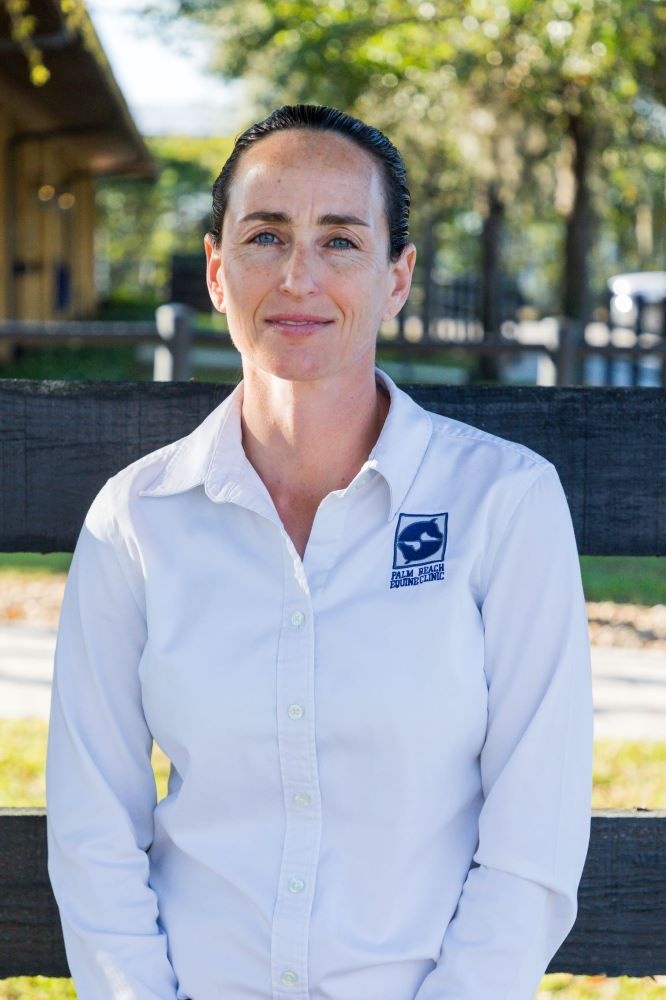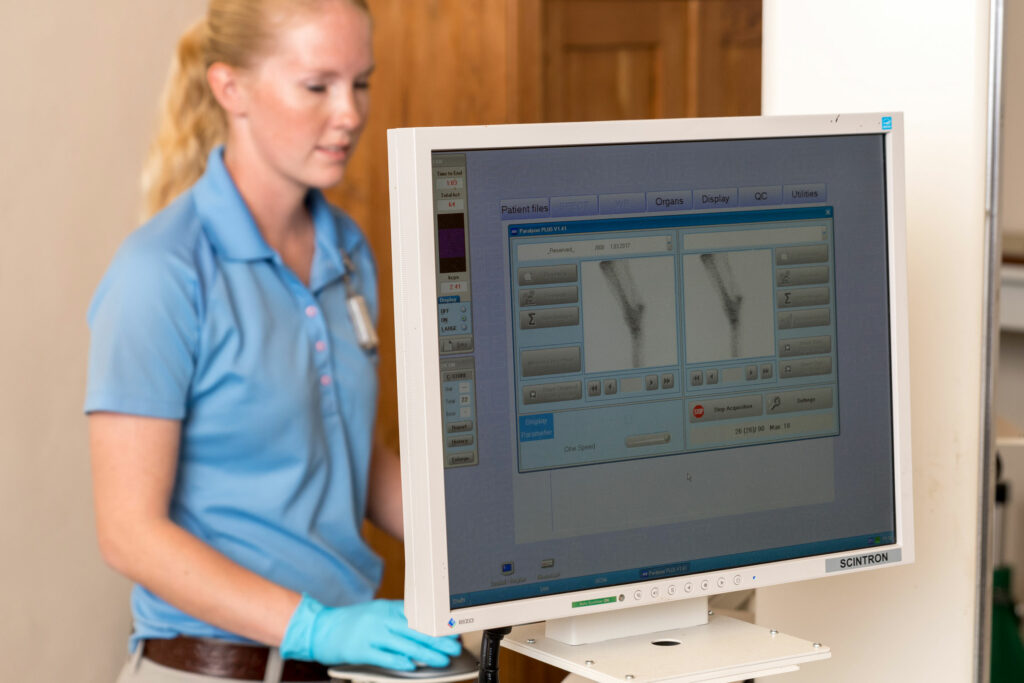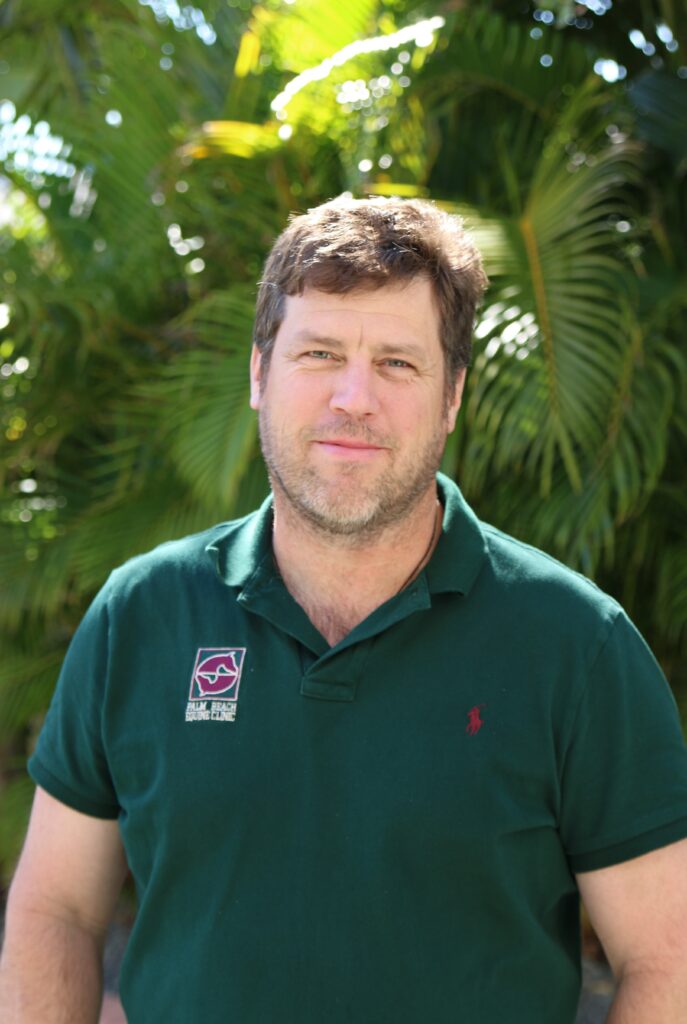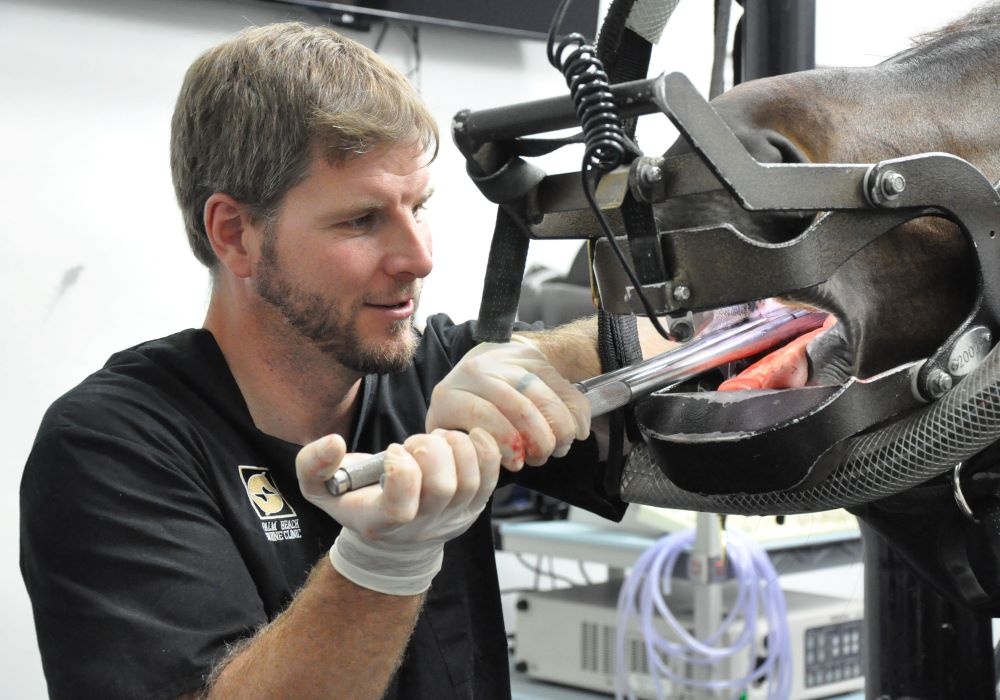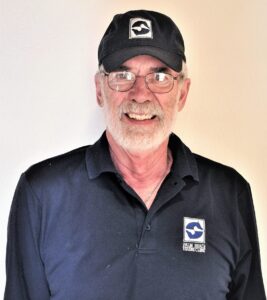As more and more international-level sport horse competitions are brought to North America, the import and export of equine athletes overseas has increased significantly. Moreover, with the winter show season in Florida, horses from around the world are about to make a pilgrimage to South Florida.
Either for a purchase or regularly scheduled show-season travel, Dr. Jordan Lewis of Palm Beach Equine Clinic works with Florida state veterinarians to simplify the process of importing and exporting horses to and from international destinations.

Where to Begin
The transport process begins with obtaining travel documents, including an equine passport and health certificate, and organizing travel arrangements with a professional equine shipper. Once travel is organized, checking the horse’s health is suitable for traveling is always the top priority.
“The most important thing to have in order is health records, up-to-date vaccinations, and complete preventative care,” said Dr. Lewis. “Much of the testing upon import and export depends on the outbreaks of different diseases in the import and export countries. The requirements change year to year and even month to month.”
Dr. Lewis is one of the many veterinarians at Palm Beach Equine Clinic who helps owners navigate through the ever-changing import, export, and quarantine regulations.
Requirements Differ Depending on the Specific Import and Export Countries
“Most horses that are coming from Europe to the U.S. to compete in Florida fly into Miami and are placed in a two- or three-day U.S. Department of Agriculture (USDA) quarantine depending on the country they are arriving from,” said Dr. Lewis. “If they are arriving from South America, however, requirements are different and they will spend seven days at USDA in Miami.”
It is there that the most current regulations are upheld and tests are performed to rule out the presence of any threatening diseases.
When importing to the U.S., Dr. Lewis affirms that many tests are required through bloodwork, including equine infectious anaemia (EIA) or coggins; piroplasmosis, which is a tick-borne disease; glanders, a common bacterial disease; and dourine, a parasite-born venereal disease. When traveling from South America, horses are also tested for other parasites, such as screw worms. When exporting from the U.S., testing will vary based on the regulations of the destination country, its current health precautions and common parasites or diseases.
CEM Quarantine
Once the initial quarantine is complete, geldings are released into the general population, while stallions and mares are transitioned to Contagious equine metritis (CEM) quarantine at either a commercial or private quarantine facility.
CEM is a venereal disease in horses caused by bacteria and is only spread during breeding or through infected semen during artificial insemination. CEM quarantine is recommended for all horses entering the U.S. from Europe, but not necessary for those flying in from South America as the disease is not present in those countries.
According to Dr. Lewis, CEM quarantine takes about 15 days for mares and 35 to 40 days for stallions. Taking this into account, she recommends owners plan a month to complete the travel regulations for a mare and two months for a stallion. Horses that are continually showing obviously don’t have this time built into their travel schedules, and that is where waiver tents enter the equation.
Mares and stallions that bypass CEM quarantine are shipped in a sealed trailer to the competition facility where they enter quarantine in a waiver tent to keep them secure from the general horse population while competing.
If horses are admitted into a traditional CEM quarantine, veterinarians like Dr. Lewis perform the appropriate tests and cultures that clear a horse for approved release into a new home or to the event.
“We work very closely with state veterinarians to do all the blood draws and testing for imported horses, as well as stay on top of the requirements of export countries so each horse can easily and safely transition into the equine population,” said Lewis.
While requirements may change often, the ultimate goal of veterinarians like Dr. Lewis and her colleagues remains the same: releasing safe, healthy, and happy horses to travel into the U.S. and all countries around the world.
Horses are competing around the world more than ever. It is important for all horse owners to implement a routine for vaccinations and biosecurity protocols to keep their horses healthy. Many infectious diseases are easily transmitted between horses and spread quickly through a stable or showground if the proper measures are not taken. The veterinarians at Palm Beach Equine Clinic are very experienced with isolation cases and always available to discuss the important steps that should be taken to maintain effective biosecurity protocols. Palm Beach Equine Clinic encourages owners to reach out to their veterinarians at any time for more information or alert doctors of a suspected potential risk.
Preventative Equine Healthcare
The best first line of defense for horse owners is to maintain current equine vaccinations. Equine Influenza and Equine Herpes Virus (EHV-1) are two deadly diseases that are highly contagious and should always be included in a routine vaccination program. In the United States, it is now required for all horses attending a USEF competition to be vaccinated for Equine Influenza and EHV-1 prior to any event. Official documentation of vaccinations being administered within the previous six months must accompany the horse to the competition.
Vaccination does not guarantee absolute protection against any diseases, and biosecurity measures should also be taken as added protection.
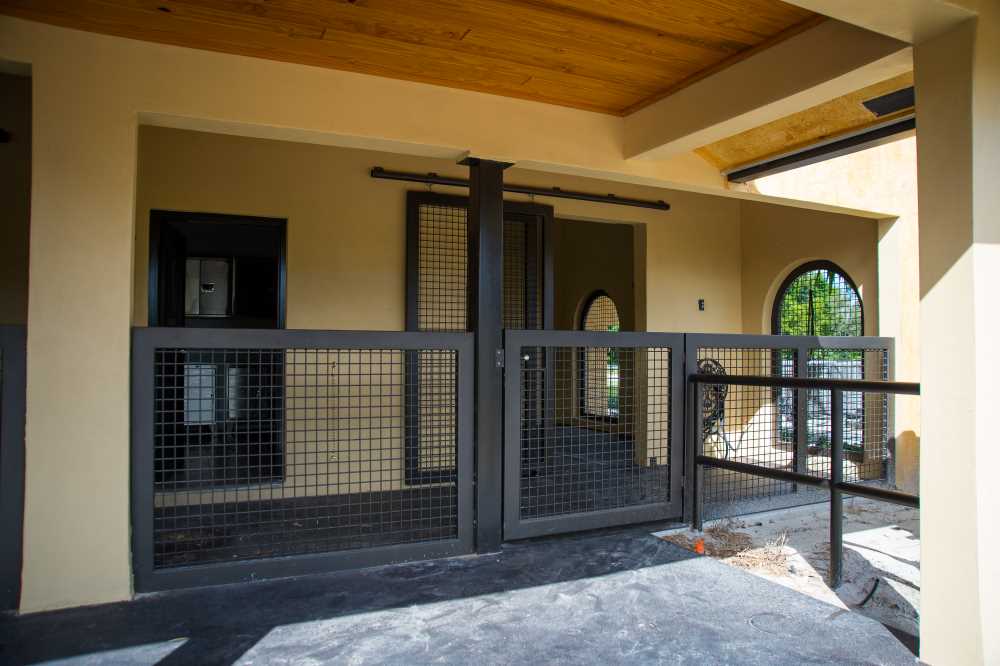
Biosecurity is a preventative measure taken to reduce the risk of transmission of infectious diseases by people, animals, equipment, or vehicles. Biosecurity is important at all times, even when an outbreak has not occurred.
The Stress of Travel
Owners that use commercial transport for their horses should confirm that the trailers have been disinfected between each shipment. Trailers should always be well ventilated, and horses should be provided with fresh, clean water at all times. The stress of travel can decrease a horse’s immune system, causing more vulnerability to disease. It is important to monitor your horse’s behavior and health closely before, during, and after traveling.
Preventing the Spread of Diseases
Simple day-to-day practices in health care and hygiene are also very important in reducing the risk of contracting an infectious disease. Washing hands between grooming horses and regularly cleaning grooming supplies can reduce the spread of infection. When attending a horse show or moving horses to a new location, a footbath for all persons entering or leaving the barn at each doorway can be effective in disinfecting shoes to reduce tracking disease into the barn. If horses are showing a depressed attitude, have stopped eating, are running a fever, and/or have a runny nose, contact your veterinarian immediately. Early medical attention for an infectious disease makes a large impact on the recovery of your horse and the equine community’s safety.
The best way to safeguard any horse’s health is to keep the immune system strong with support from a suitable nutrition and exercise program. Vaccinations, a proper deworming program, and biosecurity practices will provide additional protection.
Palm Beach Equine Clinic prides itself as being a consistent leader in sport horse medicine and continues to expand the diagnostic imaging technologies to provide the best services for clients. In addition to state-of-the-art imaging technology available on-site, Palm Beach Equine Clinic is fortunate to work directly with world-renowned Board Certified Radiologist Dr. Sarah Puchalski.
Dr. Sarah Puchalski is a Diplomate of the American College of Veterinary Radiology whose specialty includes the interpretation of diagnostic imaging including Radiographs, MRIs, Nuclear Scintigraphy, and CT scans. Dr. Puchalski’s job requires a high level of specialization to properly review imaging to produce comprehensive written reports for referring veterinarians. In addition to her full-time position with PBEC, Dr. Puchalski reads imaging cases for clinics all over the world. Many veterinarians and owners request a consultation as a second opinion on Pre-Purchase examinations radiographs and ultrasound evaluations.
Pioneering Equine Diagnostic Imaging Modalities
Palm Beach Equine Clinic has always been a pioneer in advances of technology within the equine veterinary industry. Almost 30 years ago, Palm Beach Equine Clinic bought the first ultrasound for equine practice in South Florida. Twenty-five years ago, Palm Beach Equine Clinic installed the first Nuclear Scintigraphy gamma ray camera to perform bone scans. Twenty years ago, Palm Beach Equine Clinic assisted in developing Computed Radiography (CR) for horses. Currently, Palm Beach Equine Clinic has the most advanced surgical and diagnostic imaging equipment available, including a standing MRI unit, MiE gamma ray camera, Digital Radiography, Video Endoscopy, and a bevy of additional diagnostic equipment.
“Palm Beach Equine Clinic has a great case population and great equipment, which is a huge bonus for someone doing what I do,” Dr. Puchalski stated. “The equipment is exceptional, the technical staff is excellent, and the case population of the region is obviously amazing.”
Nuclear Scintigraphy Imaging
Palm Beach Equine Clinic proudly offers an updated Nuclear Scintigraphy lab (bone scan) that houses the MiE Nuclear Scintigraphy gamma ray camera. Nuclear Scintigraphy is typically used to diagnosis injuries or bone remodeling within the skeletal anatomy of the horse. This specialized camera is equipped with sharper contours for precise imaging that results in accurate lameness diagnoses. Advanced software provides the ability to acquire high quality images despite small movements from the patient. This feature reduces the time required to complete a study, which provides quicker results.
Bone scans are also very useful in defining multi-limb lameness origins for the hard to diagnose, long-duration lameness cases. Typically, Nuclear Scintigraphy scans isolate points of injury to be identified further with other diagnostic techniques, such as digital radiology and magnetic resonance imaging (MRI).
The clinic offers an MRI lab containing the innovative Equine Standing MRI manufactured by Hallmarq, which scans the equine distal limb in a standing position requiring only light sedation. MRI is very useful to further define a suspected lameness origin by acquiring more defined images of boney and soft tissue structures.
As one of the top equine medical centers, Palm Beach Equine Clinic has the pleasure of working with many highly specialized, world-class equine professionals. Dr. Peter Heidmann, DVM, DACVIM, is a Diplomate of the American College of Veterinary Internal Medicine, as well as the Owner/Hospital Director of Montana Equine Medical and Surgical Center in Three Forks, MT. In conjunction with a busy schedule of managing Montana’s leading full-service equine referral practice, Dr. Heidmann joined the team at Palm Beach Equine Clinic in Wellington, FL, for the first time this past winter to share his expertise in internal medicine. Dr. Heidmann is scheduled to return again for the 2017 winter season.
Dr. Heidmann grew up in New England and in the year 2000, graduated from Tufts University in Massachusetts with his veterinary degree. He completed his required internship at Arizona Equine, followed by a one-year surgical fellowship at Oregon State University. Beginning in 2002 to 2005, Dr. Heidmann completed a residency for Internal Medicine at the University of California, Davis.
Following his residency in 2005, Dr. Heidmann began his career with a private veterinary practice in Montana. Then an unfortunate turn of events quickly changed his new employment. Dr. Heidmann’s predecessor in Montana passed away in a tragic car crash on the last day of the year, and Dr. Heidmann stepped up to continue to build the practice left to him. Over the last ten years, Dr. Heidmann has developed Montana Equine to include two satellite offices and six senior veterinarians, plus become the leading referral hospital in the state.
As a Board Certified Internal Medicine Specialist, Dr. Heidmann specializes in neonatology, infectious disease, and ultrasound. In addition to his core internal medicine interests, Dr. Heidmann’s strengths also include advanced performance evaluations.
Dr. Heidmann was recruited by Dr. Scott Swerdlin, President of Palm Beach Equine Clinic, during the fall season of 2015. Dr. Heidmann’s wife, Allison, is a professional jumper and enjoys showing at the Winter Equestrian Festival (WEF). When Dr. Swerdlin offered Dr. Heidmann the opportunity to join PBEC and spend the winter in Wellington, he jumped at the opportunity.
“It worked out really well for me, for family reasons as well as professional reasons, to come down and do internal medicine specialty work during the winter in Wellington,” Dr. Heidmann detailed. “It is nice on the professional front, because Montana is the fourth biggest state, but the second lowest in per capita people. There are a lot of horses there, but there is not a lot of specialty horse work during the winter, so it was really nice to be able to work with the caliber of athletes that are at the WEF and come into Palm Beach Equine Clinic.”
“The facilities are really nice, and I am excited about the improvements they are making, because what was already there was incredible,” Dr. Heidmann said, pointing out recent renovations that are currently underway at the clinic. “It is great to have those resources at your fingertips, not just imaging and equipment, but the staff and variety of expertise. In Montana, I have six or seven veterinarians to bounce ideas off of, and all of a sudden at PBEC I had 30 people with different perspectives, and different backgrounds, and training. You get to see different ways of doing things and see how things can be done even more efficiently. I really emphasize the staff as much as the bells, whistles, and equipment.”
“There are not a lot of us Board Certified Internal Medicine veterinarians, because it is perceived as kind of an egghead, academic sub-discipline of equine work,” Dr. Heidmann admitted. “But what we focus on, especially in healthy horses like the athletes at WEF, are performance issues. Two of the most common, classic, performance-limiting issues in athletes, and especially in sport horses, are respiratory problems and muscle problems, which can range from quite subtle to severe.
“Muscles problems can be subtle issues that involve mild tweaking in diet or micronutrients, or they can be more severe issues like a horse that ties up,” Dr. Heidmann detailed, describing myopathy. “Similarly with respiratory problems, it can be a mild issue where the trainer or rider thinks that the horse used to be better or just is not performing up to its potential. It can be subtle respiratory problems like shortness of breath, or loud breathing, or slow recovery after work, or it can be more severe things like respiratory infections.”
Muscle issues and respiratory problems are the two main areas of internal medicine expertise, but the specialty can include many other things, such as liver problems, neurologic problems (brain and spinal cord both), and the care of sick neonates (foals).
“With seasonal breeders, that three-month period in Wellington is a high time for foals being born, and there is really a great deal that we can do with sick babies to end up with a healthy athlete in the end,” Dr. Heidmann noted. “Many people do not even realize what is possible with sick babies. It is possible to recover a top-notch performance horse out of a foal that looks quite dire.”
While Dr. Heidmann specializes in internal medicine, he and all of the veterinarians at Palm Beach Equine Clinic are very knowledgeable and experienced in general medicine practices.
“All of us in equine work are put in positions where we are generalists too, but what I really enjoy about being part of the team at PBEC is being able to focus on my true specialty,” Dr. Heidmann acknowledged. “This is what I spent so much time training to do, and to really be able to go in-depth, not just with the performance horses but non-WEF horses that are in the area as well, is a wonderful experience. We can really offer a level of treatment that is relatively rare in private practices.”
About Palm Beach Equine Clinic
The veterinarians and staff of Palm Equine Clinic are respected throughout the industry for their advanced level of care and steadfast commitment to horses and their owners. With 30 skilled veterinarians on staff, including three board-certified surgeons, internal medicine specialists, and world-renowned board-certified equine radiologists in the country, PBEC is known for leading the industry in new, innovative diagnostics and treatments. Palm Beach Equine Clinic provides experience, knowledge, availability, and the very best care for its clients. Make Palm Beach Equine Clinic a part of your team! To find out more, please visit www.equineclinic.com or call 561-793-1599.
More about Dr. Heidmann
Dr. Heidmann sees referrals and consults on cases from veterinarians throughout Montana and has served as an expert witness in many legal, welfare, and insurance cases. He served as the Internal Medicine Specialist for the 2011 Pan American Games in Guadalajara, Mexico, and participated as one of the founding veterinarians of Montana State University’s Bioregions program to Mongolia in 2014. He is Adjunct Faculty at Washington State University’s School of Veterinary Medicine in Pullman, WA, and Affiliated Faculty at Montana State University, Bozeman.
Regular, routine veterinary care is important to maintaining optimal equine health. Dental care, vaccinations, deworming, and annual physical examinations keep horses healthy and can identify problems early. It is very important that horse owners have a veterinarian who is familiar with their horses and provide routine care.
At Palm Beach Equine Clinic, every veterinarian values the importance of preventative equine medicine, and some have taken a specialty to treatments, including equine dentistry.
Equine Dentistry
Proper dental care is essential to the well-being and peak performance of every horse. Dental maintenance keeps horses working well, performing well, and most importantly, eating well.
It is important to get the horse’s teeth examined and regularly floated at least once a year and sometimes more frequently in older horses. The veterinarians of Palm Beach Equine Clinic are available to visit clients at their farms to perform thorough dental evaluations and “float” the teeth – a term that refers to the veterinarian wearing down the surface of the teeth, usually to remove sharp points or balance out the teeth in the mouth. During the routine examination, the veterinarian will also look for any other dental problems that the horse may have, such as a tooth abscess.
Regular dental care may help to prevent premature tooth loss and promote more complete utilization of feed. A horse with uneven teeth due to wear and tear is going to poorly grind up food creating issues with digestion. This could lead to colic, choke, or other serious complications. Sharp or uneven teeth can also cause pain due to the misfit of a bit on uneven teeth and contribute to poor performance or misbehavior. These problems can quickly be alleviated and prevented with proper care.
With Palm Beach Equine Clinic’s advanced technology, the veterinarians are able to perform more cutting-edge, specialized treatments beyond routine dentistry. Veterinarians are able to perform tooth extractions as needed for horses suffering from a tooth abscess or fracture. With the surgical staff at Palm Beach Equine Clinic, which includes three board-certified surgeons, dental surgeries, sinus surgeries, or similar procedures are easily performed at the clinic.
Preventative Equine Medicine
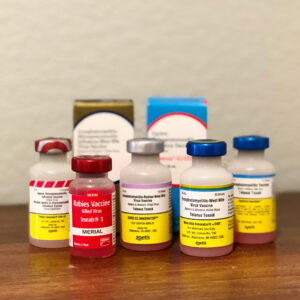
Along with dental care, Palm Beach Equine Clinic offers further preventative equine medicine, including worming protocols for parasite control and routine vaccinations.
Palm Beach Equine Clinic strongly suggests a fecal test to evaluate your horse’s internal parasite count on a routine basis. In Florida, the peak worm season is year-round due to the lack of frost. The effectiveness of different dewormer products can be measured using a simple fecal egg count reduction test, which involves performing a fecal test before and after deworming your horse. Equine tapeworms are also difficult to identify in fecal examinations. Deworming for tapeworms is strongly recommended annually with a product containing Praziquantel.
Establishing an effective deworming program for equine parasites has become an open topic for discussion on which method is most effective. Veterinarians have changed their views on worming in recent years, noting that minimal parasite load within the horse’s hind gut is actually helpful in producing a natural immunity; however, it is crucial to control the parasitic load.
Environmental management is imperative to equine parasite control. Due to the emergence of new resistant parasites, preventative measures in proper barn management should be added to routine rotational treatment with anthelmintic medications to properly control parasite exposure.
Protecting Your Horse from Infectious Diseases
Palm Beach Equine Clinic also stresses the importance of vaccinating horses against infectious diseases, especially with horses that travel. Highly contagious diseases such as Eastern Equine Encephalitis (EEE), the Equine Herpes Virus (EHV-1), and the West Nile Virus are just a few illnesses that often result in equine fatalities and should be taken very seriously.

Routine vaccinations are imperative to protecting horses from disease and are also a requirement to attend many horse shows. Palm Beach Equine Clinic can prepare horses for travel, whether within the U.S. or going to or from Europe.
The best defense for horse owners is to maintain current equine vaccinations to protect their horses. Vaccinating at the proper time of the year is critical, and boosters should be given regularly. Consult with your veterinarian for further guidance on when and how frequently different vaccinations should be administered.
Whether it is a top-level show horse or a backyard pet friend, the veterinarians of Palm Beach Equine Clinic are here to help with all maintenance needs. For questions or more information, please call Palm Beach Equine Clinic at 561-793-1599.
Palm Beach Equine Clinic is proud to have beneficial consulting relationships with many equine medical professionals throughout the country, including Dr. Stephen E. O’Grady, DVM, MRCVS, of Virginia Therapeutic Farriery. Dr. O’Grady provides advanced services in equine podiatry, offering comprehensive diagnosis, treatment, and maintenance for a variety of foot conditions using medical therapy as well as therapeutic shoeing.
Palm Beach Equine Clinic features the services of Dr. O’Grady for consultations year-round. With the experience and expertise of its world-class veterinarians, in addition to Dr. O’Grady’s wealth of knowledge, the Palm Beach Equine Clinic is able to provide the very best in advanced treatments in equine podiatry.
Equine Podiatry Services
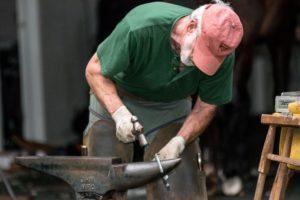
There is no structure on the horse that is as susceptible to injury, disease, or “wear and tear” than the equine foot. Proper, timely hoof care can often make the difference between a sound performance horse and one with chronic lameness. Some of the problems that Dr. O’Grady consults on include:
- Hoof Diseases
- Laminitis
- Severe Infections
- Advanced White Line Disease
- Therapeutic Horseshoeing
- Hoof Wall Defects
- Juvenile Orthopedics
Equine podiatry requires extensive knowledge of hoof anatomy, physiology, biomechanics and diagnostic imaging, as well as the farrier skills necessary to implement specialized shoeing. The combination of being educated as both a veterinarian and a professional farrier allows Dr. O’Grady to treat each foot problem with an understanding of the medical physiology and the mechanics involved. This blending of the two professions allows him to comprehensively diagnose, treat, and design a maintenance plan for a variety of foot conditions using medical therapy as well as therapeutic farriery. Dr. O’Grady also works together with referring veterinarians on difficult cases to discuss and assist with a plan that works for all parties.
Diagnostic Imaging for Equine Podiatry Cases
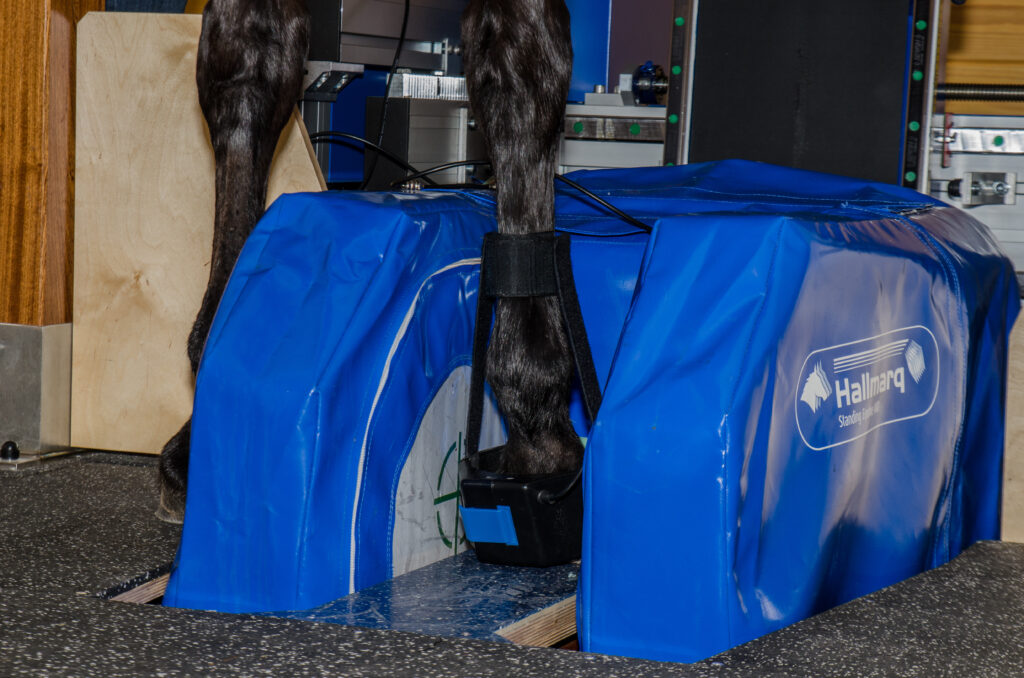
The advanced imaging equipment at Palm Beach Equine Clinic, in combination with Dr. O’Grady’s expertise, allow for comprehensive diagnosis and treatment of all hoof-related conditions. Palm Beach Equine Clinic offers a Hallmarq standing MRI that can provide a detailed diagnosis of any foot issues. Medical therapy, such as surgery and various medications, are often combined with therapeutic farriery for the best possible results. Dr. O’Grady’s methodology centers around using the basic principles of farriery, and when necessary, combining these principles with advanced technology and improved farrier products available on the market.
Equine podiatry consultations can be used for a variety of complicated hoof conditions where the problem is severe, chronic, and non-responsive to the present treatment. Hoof problems can include severe injuries, acute or chronic laminitis, hoof wall defects (non-healing quarter or toe cracks), hoof capsule distortions (club feet, long toe under-run heels), and severe hoof disease (infections, WLD, canker). There are many hoof-related problems that benefit from the advanced technology and farrier techniques available today.
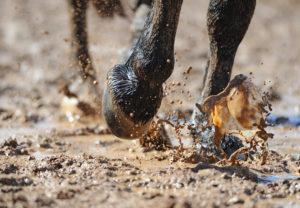
Thrush, rainrot, and scratches are problems that most equestrians have probably encountered, but in the hot, wet climate of South Florida, these issues can incessantly plague horses and their owners. While different in their presentation, thrush, rainrot, and scratches have a lot in common. For horse owners, there are several problems that arise due to environmental factors or predisposing conditions, but these issues can easily be prevented or treated with proper care and management.
This month, Palm Beach Equine Clinic’s Dr. Bryan Dubynsky shared his expertise on the causes, treatment, and prevention of thrush, rainrot, and scratches.
What is Equine Thrush?
Thrush is an infection within the horse’s hoof, most commonly caused by bacteria that invade the deeps clefts or grooves (known as sulci) of the frog. Fusobacterium Necrophorum is the common bacterial culprit, which naturally occurs in the environment, especially in wet, muddy, or unsanitary areas. Thrush bacteria thrives where there is a lack of oxygen.
Causes of Equine Thrush
Some horses are predisposed to developing thrush due to conformation, such as a rather high heel or deep sulci, or a narrow or contracted heel. The bacteria will manifest in horse’s feet that are not picked out regularly, or standing in muddy, wet environments, including paddocks or stalls that have not been cleaned properly.
Thrush can typically be first identified by the odor. The frog will have a strong, rotten odor and become spongy. Visually, the frog can even exudate (oozing) pus.
Treating Equine Thrush
The treatment for Thrush is fairly simple as it is very sensitive to oxygen. The most important thing is to have your vet or farrier trim or debride the frog to expose areas to the air. It is best to keep the hoof clean and dry. Adding a common detergent to the Thrush areas, such as Betadine or any commercial product (Thrush Buster, Coppertox, etc.) will help to kill the bacteria. Most importantly, if the horse is not removed from those predisposing environmental factors, treatments can be ineffective.
Maintaining a level of activity for our equine partners will increase blood flow to the feet and promote health to the area. Horses found in dry environments with ample space to move typically do not suffer from Thrush. The activity of horses moving keeps the frogs healthier. The more blood flow you have in the foot, the less chance that infection is able to manifest.
Thrush is not guaranteed to cause lameness. In extreme rare cases, Thrush can penetrate deeper and cause an infection in deeper tissue or even in the coffin bone. When in doubt, always contact your veterinarian.
What is Equine Rainrot (Dermotophilus Congolensis)?
Rainrot is caused by a naturally occurring bacteria named Dermotophilus, which produces spores. rainrot is recognized as scabby, scaly, crusty spots on areas of the horse that have been exposed to rain. It is commonly seen on the neck or across the back (dorsum). rainrot is not typically apparent on the legs or under the belly.
Causes of Rainrot

When there is a break in the skin, which can be even as simple as an insect bite, a surplus of rain on the skin washes away the natural protective oils. Once the skin is stripped of the natural protective layer or any sort of trauma to the skin barrier occurs, those spores are able to invade the deeper dermis skin layers. The spores penetrate into the deeper layers of the dermis, and the body reacts by sending white blood cells and proteins to fight the invaders. This reactive response causes the small pustules, scabs, and bumps to form.
Similar to thrush, rainrot is an environmental issue. It is most commonly seen in warm areas with high humidity, excess rain, and insects. The most important prevention is to keep horses out of the rain for prolonged periods of time. A horse can be out in the rain for short periods of a day or two, but if it is constantly in hot and rainy conditions with biting insects, more than likely the horse will develop rainrot.
Treating Equine Rainrot
Dr. Dubynsky emphasizes that topical products are not worth anything if the horse is not removed from the environmental factors. Once you remove the environmental factors, a keratolytic agent (something that exfoliates keratin), such as Benzoyl Peroxide or an antibacterial shampoo will help the skin heal. He also cautions that if the horse does have scabs, you do not necessarily want to pick the scabs off because then you are just leaving open skin without protection for more bacteria to invade. The most important tip to healing is to keep the area dry.
In very rare, severe cases of rainrot, it is best to contact your veterinarian to put the horse on antibiotics. If left untreated, and the horse is not removed from the environmental causative factors, the infestation can lead to Staphylococcal Folliculitis; a type of Staph bacteria that will invade the hair follicles and cause a more serious situation.
What are Equine Scratches?
Scratches is a generic term for many different ailments. The definition of scratches can be a bacterial, fungal, or viral dermatitis or inflammatory condition of the pastern or fetlock. It is defined as a chronic Seborrheic Dermatitis (flaking of the skin), characterized by hypertrophy (enlargement of tissue from an increase in cells) and exudation (escape of liquid from blood vessels through pores or breaks in the cell membranes) on the rear (palmar plantar) surface of the pastern and fetlock.
Causes of Equine Scratches
There are certainly predisposing factors for Scratches, including the same environmental factors that cause Thrush or Rainrot. Predisposing factors for Scratches include horses that are bathed often or stand in wet conditions all the time. Horses that have an excess amount of hair on their legs, especially draft horses, also develop scratches easily because the hair traps dirt and moisture on the skin.
Scratches can develop in horses that are bathed too often such as the intensely managed show horse. The show horse is desired to be very clean, which can mean several baths a day. This will strip away the natural protective oils and barrier of the dermis, which allows bacteria or fungi to invade. When moisture penetrates the skin, it causes inflammation reacting with heat, redness, pain, and loss of protection to keep bacteria out.
Prevention and Treatment of Equine Scratches
The most effective first step for prevention and treatment should be to remove the environmental predisposing factors. Removing excess hair during the humid months and keeping horses clean and dry to the best of your ability will reduce the probability of developing an infection. Bathing horses once a day with Betadine or antifungal/antibacterial shampoo will help to clear the infection. Be sure to leave the shampoo on for 20 minutes for all of the medicine to penetrate, rinse thoroughly, and make sure the horse is completely dry. In order to effectively treat the bacteria, horses should be completely towel or air dried before returning to their stalls or paddocks.
As always, contact your veterinarian immediately if there appears to be deeper infection present, or you would like more detailed information on how to treat and prevent these bacterial infections. For more information, contact Palm Beach Equine Clinic at 561-793-1599.
The 2016 Olympic Games in Rio de Janeiro, Brazil is finally here and Palm Beach Equine Clinic is proud to have its own Dr. Jorge Gomez present to provide veterinary support for some of the world’s most elite horses. Dr. Gomez is not only a top sport horse practitioner, but is also a renowned Board-Certified Surgeon.

Dr. Gomez will be in attendance at the prestigious Games to serve as the veterinarian for the team horses in show jumping events representing Venezuela and Colombia held August 14-18. Two elite horse and rider combinations competing for individual medals will represent each country. On behalf of Colombia, Daniel Bluman with Apardi and Rene Lopez aboard Con Dios III will compete individually. The riders representing Venezuela competing for individual medals include Pablo Barrios riding Antares and Emanuel Andrade with Hardrock Z.
Olympic Veterinary Responsibilities
There is a tremendous amount of work that is required in preparing and maintaining a top performance horse for a significant world championship event such as the Olympic Games. While in Rio, Dr. Gomez will closely monitor that each horse is in optimal health conditions while competing. He is responsible for providing and administering permitted medications for muscle, joint, and tendon support, as well as vitamins and intravenous fluids, if necessary. Dr. Gomez also assists the competitors by providing and prescribing physical alternative therapies that help maintain the horse in the best possible form for competition.
There is a tremendous amount of work that is required in preparing and maintaining a top performance horse for a significant world championship event such as the Olympic Games. While in Rio, Dr. Gomez will closely monitor that each horse is in optimal health conditions while competing. He is responsible for providing and administering permitted medications for muscle, joint, and tendon support, as well as vitamins and intravenous fluids, if necessary. Dr. Gomez also assists the competitors by providing and prescribing physical alternative therapies that help maintain the horse in the best possible form for competition.
Dr. Gomez, originally from Colombia, has been affiliated with Palm Beach Equine Clinic since 2011 and has since represented the clinic at the 2012 Olympic Games in London, England, the 2015 Pan American Games in Toronto, Canada, and the 2014 Alltech FEI World Equestrian Games in Normandy, France.
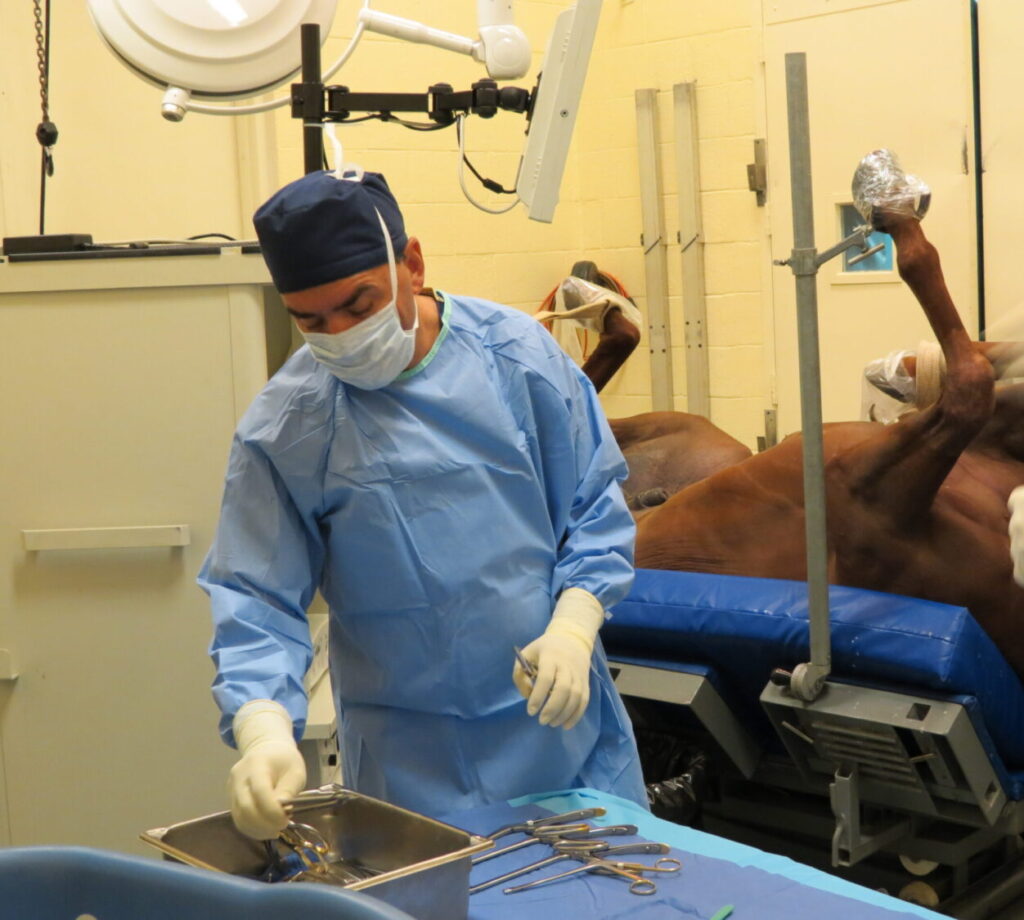
“It is a good opportunity to meet people at all levels and from all over the world that are involved in equestrian sports,” Dr. Gomez said of representing the clinic worldwide. “Palm Beach Equine Clinic becomes a familiar place for all those acquaintances to come to and to refer their horses when they come to Wellington. Many of the horses that we take care of during the Winter Equestrian Festival in Wellington are referred to us because of the connections that we have made at the international competitions.”
Caring for Olympic Equine Athletes
Since he has served at many major international events, Dr. Gomez understands the larger significance of preparing for the Olympic Games. An Olympic medal is a lifelong dream for most grand prix competitors, and having the right horse in peak condition is essential.
“Caring for the horses at the Olympic Games is the same as any other competition, but there are maximal responsibilities,” Dr. Gomez detailed. “Because of the nature of the event, riders want us to be checking the horses entirely on a daily basis for at least one week before the event starts.
“Of the four horses that will be under my care, three of them are my regular clients, so I keep a fairly close eye on them already,” Dr. Gomez added. “In conjunction with trainers and riders, we planned a schedule that we think is the best for the event. I look forward to the competition, and I hope that the horses under my care perform according to expectations.”
Palm Beach Equine Clinic, the industry leader in sport horse veterinary care, features an illustrious list of veterinarians who are experts in their respective fields. Dr. Gomez and PBEC’s team of 30 veterinarians, including Board-Certified Surgeons and Radiologists, are available to provide services to clientele throughout North America and around the world in the various horse sport disciplines
Equine Ophthalmology
Article by Susan M. Carastro, DVM, MS
Diplomate, American College of Veterinary Ophthalmologists
Palm Beach Equine Clinic is proud to have great consulting relationships with many equine medical professionals throughout the country, including Susan M. Carastro, DVM, MS, of the Animal Eye Specialty Clinic. A Diplomate of the American College of Veterinary Ophthalmologists, Dr. Carastro shared her expertise on some of the most common diseases of the equine eye.
Understanding the Equine Eye
Equines have a uniquely developed eye suited to accommodate the lifestyle and needs of our equine companions. The location of the equine eyes being on the side of the head allows for a more panoramic view for protection. This is imperative to the fight or flight response as visual detection of a threat is necessary to alert the flight animals to flee.
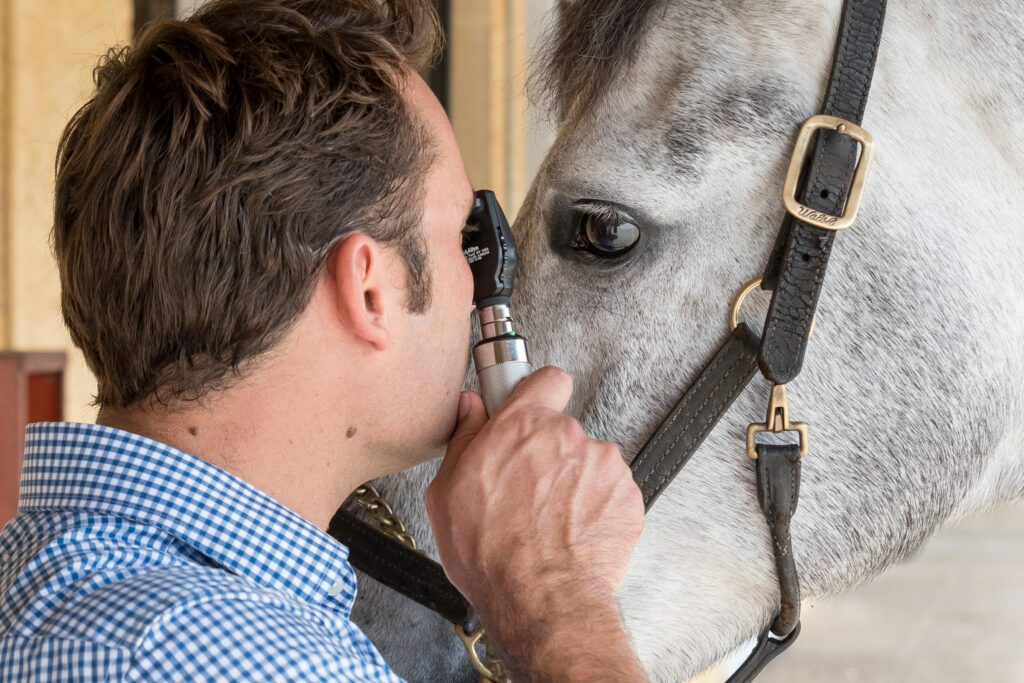
Protecting the Horse’s Eyes
There are a few common diseases of the equine eye that are worth having basic knowledge about. Early recognition and proper treatment is ideal to minimizing damage to the eye. Eyelid cuts or lacerations can occur with contact of numerous objects, but most commonly occur with catching the eyelid on a metal S ring on buckets or nails, or splits in the lid margin from blunt trauma. Eyelid lacerations are easily identified and repaired with primary closure or suturing.
The eyelids have an extensive blood supply and can bleed excessively. As long as the globe is not damaged, the eyelids have an excellent capacity to heal with minimal impact on ocular health. No matter how extensive the laceration appears, every attempt should be made to salvage as much eyelid margin as possible. Allowing the eyelids to heal without suturing can result in poor cosmetic appearance, enhanced scarring, and irregular eyelid margins. The scarring can result in hair or lashes contacting the cornea surface causing chronic irritation or discomfort.
Corneal injuries are one of the most common vision-threatening and painful equine eye diseases. The cornea is the front clear part of the eye that protects the delicate intraocular structures. Ulcers are generally due to abrasion or puncture with environmental objects (hay, branches, and sand). Clinical signs of a corneal ulcer include squinting, tearing, swelling around the eye, redness to the eye, and/or cloudiness to the eye. Corneal ulcers can be confirmed by careful examination of the equine eye and staining with a green dye (fluorescein). Uncomplicated superficial corneal ulcers can heal without leaving any residual damage. Once an ulcer has occurred, the main concern is the risk of corneal infection. Topical therapy with antibiotics, as well as anti-fungal agents four times daily is recommended until the ulcer heals.
Equine Eye Infections and Conditions
Bacterial and/or fungal corneal infections can be devastating and result in loss of vision and the eye. These infections are more common in the southeastern United States with the heat and humidity supporting the growth of these organisms. If a corneal infection occurs, aggressive topical therapy up to every hour and in many cases, surgery, is necessary to save the eye.
Hourly medication can be quite difficult due to personal time constraints, and the horse will keep the eye forcefully closed because of the pain and light sensitivity. A subpalpebral lavage system can be placed for easier and more effective treatment. This is a small tube or catheter inserted through the upper or lower eyelid with the injection port being attached to the mane near the withers. The lavage allows for medication to be injected through the catheter to reach the eye without coming near the horse’s head. Corneal infections in horses can take months to clear. Corneal ulcers can also be extremely painful, thus pain control with atropine and banamine will minimize discomfort and distress.
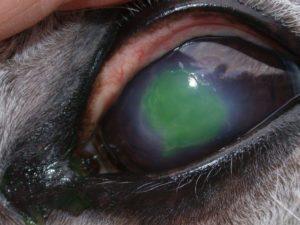
Equine recurrent uveitis or moon blindness affects horses worldwide. Uveitis is an inflammation of the iris (colored part of the eye) that can be caused by numerous issues. These include trauma, infections in other parts of the body, or can be generated by the horse’s own immune system, but there is also a genetic predisposition for Appaloosas and Draft breeds.
Signs and Treatment of Equine Recurrent Uveitis
Clinical symptoms of uveitis include a painful eye (squinting, tearing), cloudiness to the eye, and swelling around the eye. If uveitis is diagnosed, evaluation for infections or inflammations elsewhere in the body should be pursued. This may include bloodwork, titers for specific infections including Leptospirosis, abdominal ultrasound, chest radiographs, and sampling of fluid from inside the equine eye.
If no underlying cause can be identified, the main goal is minimizing inflammation inside of the eye to control pain and limit the impact on vision.
Treatments that are used include topical steroids and nonsteroidal agents, oral steroids and nonsteroidal agents (banamine/bute), and atropine.
Management
The frustrating part of this disease is the recurrent nature. The interval of flare-ups can range between days to years in patients. Management for horses affected with uveitis is to limit the frequency and severity of the episodes with lifelong treatment. This can be accomplished with daily maintenance medication (topical and/or oral) even when there is no active inflammation. If the equine eye is still having flare-ups, surgical implantation of a device impregnated with anti-inflammatory medication called cyclosporine allows for a constant release of drug into the eye to limit episodes.
If the uveitis remains poorly controlled, further consequences including cataracts, glaucoma, and retinal detachment can result in loss of vision and a painful eye requiring removal of the eye.
Equine eye diseases can generally be managed with early recognition, assistance from your veterinarian in establishing a diagnosis, and effective treatment. Please contact your veterinarian if you notice any of the above symptoms as soon as possible, as it may save your horse’s eyesight. Any of Palm Beach Equine Clinic’s veterinarians are available to answer any questions.

In the summer months, it is extremely important to be aware of how the heat and sun can affect our horses. As the summer heats up around the country and especially in Florida, Palm Beach Equine Clinic would like to remind all equine owners to keep their horses in a cool, well-ventilated environment with protection from the hot weather.
There are many problems that can arise in the summer months from overheating, to dehydration, and even equine sunburn that owners should always keep in mind.
Covered Areas to Protect Your Horse
All horses should have access to shade and cool water throughout the day. Any exercise should be scheduled when the temperatures are lower, usually earlier or later in the day. Turnout should be limited to the night or cooler portions of the day, and fans can be provided indoors during extreme heat.
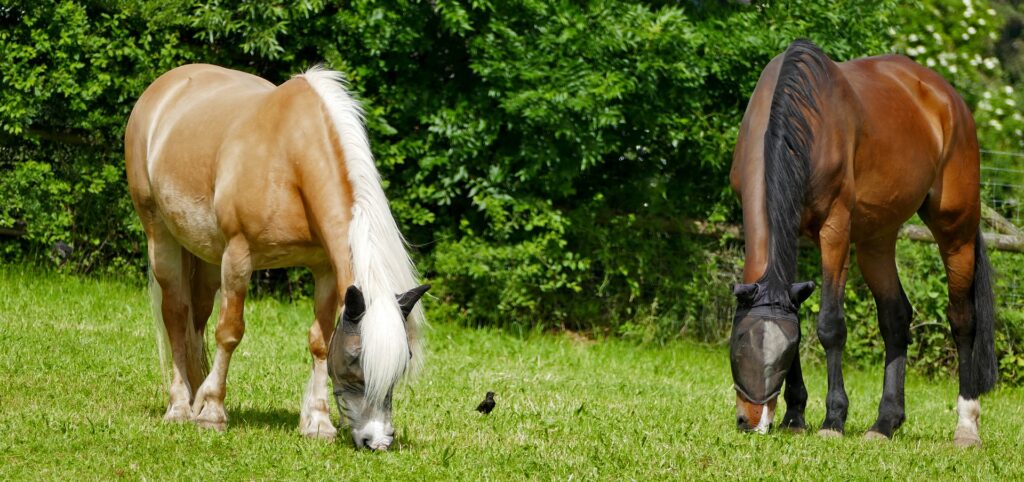
The average horse drinks between 5 to 10 gallons of water per day. It is important to provide clean, fresh water at all times and be aware of increased water necessities during extremely hot days.
Sweat and Sodium Levels
Sodium in your horse’s diet is very important to maintaining proper hydration. Providing a salt block or supplementing with electrolytes can help ensure that your horse is meeting their sodium requirements.
Especially in the extreme summer heat, horse owners should pay attention to the amount of sweat their horse is producing. Anhidrosis, or the inability to sweat normally, can be a common challenge for our equine partners in the summer months, particularly in hot, humid climates. In addition to lack of sweat, signs of Anhidrosis can include increased respiratory rate, elevated temperature, areas of hair loss, or dry, flaky skin. If you notice any of these signs, contact your veterinarian immediately.
Equine Sunburn Tips
Horses with white on their faces or bodies are especially prone to sunburn and should be protected from the harsh UV rays of the sun. Providing shade, covering your horse’s skin with fly sheets or fly masks, and applying sunscreen are all helpful ways to prevent a burn.
Fly masks are now made with extensions to cover the nose and muzzle. There are many different sunscreen products made specifically for horses, but most products approved for human use are also safe for our equine partners. Once again, horses that are particularly prone to sunburn can be kept cool and safe from the sun by staying indoors during the day and being turned out at night.
These are just a few of the important issues to be aware of during the hottest time of the year in Florida and around the country. Remember to keep your horse cool, well-hydrated, and protected from the heat and sun. Contact the veterinarians at Palm Beach Equine Clinic to learn more about precautions that can be taken to keep your horse happy and healthy throughout the summer months.
